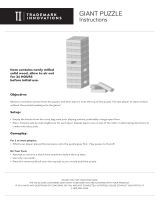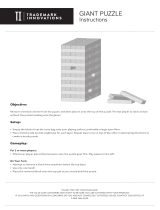Page is loading ...

Ages 4-7
EI-3078
© Educational Insights, Gardena, CA (U.S.A.). All rights reserved.
Learning Resources Ltd., Bergen Way, King’s Lynn, Norfolk,
PE30 2JG, UK. Please retain this package. Made in Taiwan.
educationalinsights.com
Hecho en Taiwan. Conservar estos datos.
Fabriqué en Taiwan. Informations à conserver.
Made in Taiwan. Bitte bewahren Sie unsere
Adresse für spätere Nachfragen auf.
Includes
colorful,
brain-boosting
puzzles!

Kanoodle Jr. is a collection of fun, logical thinking puzzles for kids. It’s great for
developing spatial reasoning and critical thinking skills. Kids will have hours of
enjoyment working on these 60 puzzles. The portable case makes it easy to take
Kanoodle Jr. anywhere!
The puzzles are leveled with stars
.
Start younger kids on one-star puzzles to introduce them to Kanoodle Jr.
Encourage them as they work on the solution. Puzzles with more stars are
harder and will take more time to figure out. With a little determination and
maybe some luck, they’ll surprise themselves, and even you!
Kanoodle Jr. comes with three types of puzzles:
1. Color-match puzzles
2. Path puzzles
3. Wall puzzles
To start, select any puzzle from the puzzle book and slide the booklet into the
case. The puzzle should show through the square openings in the puzzle board.
Solve the puzzle by placing the puzzle pieces on the board. Note: The solution
requires that the puzzle pieces lay flat on the puzzle tray (all blocks of each
puzzle piece used must touch the puzzle tray).
Instructions for Color-Match Puzzles
Puzzle pieces used: All 6 pieces.
The goal of these challenges is to use all 6 puzzle pieces to solve the color-match
puzzle.
• Cover the colored icons with puzzle pieces that match the color. (For example,
the red “Rocket”
must be covered by the red puzzle piece .)
• A puzzle piece may not cover an icon that is a different color
than the puzzle piece. (For example, the red puzzle piece can not cover the
blue “Rocket” .)
• Spaces that don’t have icons can be covered with any colored puzzle piece.
• Easier puzzles show you more colored icons. Harder puzzles
show you fewer colored icons.
Instructions for Path Puzzles
Puzzle pieces used: Determined by the puzzle diagram.
The goal of these challenges is to use the puzzle pieces to define a path between
two objects that are circled (for example the dinosaur
and the tree ).

Instructions for Wall Puzzles
Puzzle pieces used: 2, 3, 4, or 5. The player needs to figure out which ones are
needed!
The goal of these puzzles is to create a wall between the two types of objects.
For example, you want to separate the dogs
and the cats with a wall.
• Use the puzzle pieces to create the wall.
• Puzzle pieces can not cover any of the object icons.
• All empty spaces (ones without icons) must be covered.
• When the puzzle is finished, only two types of objects (for example, bears
and honey ) should be showing.
El juego portátil de puzzles Junior es una colección de divertidos puzzles de
pensamiento lógico para los niños. Es estupendo para desarrollar el razonamiento
espacial y las destrezas de pensamiento crítico. Los niños disfrutarán de horas de
diversión intentando resolver estos 60 puzzles. ¡El estuche portátil permite llevarlo
fácilmente a cualquier sitio!
Los puzzles van por niveles marcados con estrellas
.
Los niños más pequeños empezarán con los puzzles de una estrella como introduc-
ción al juego. Anímalos cuando estén intentando encontrar la solución. Los puzzles
con más estrellas son más difíciles y requerirán más tiempo para resolverlos. Con
un poco de determinación y quizá algo de suerte, se sorprenderán
ellos mismos, ¡y te sorprenderán a ti!
El juego portátil de puzzles Junior tiene tres clases de puzzles:
1. Puzzles de asociación de colores
2. Puzzles de recorridos
3. Puzzles de pared
Para empezar, selecciona cualquier puzzle del libro de puzzles y desliza el cuad-
ernillo en el estuche. El puzzle se deberá ver a través de las aberturas cuadradas
del tablero. Resuelve el puzzle colocando las piezas en el tablero. Observación: La
solución requiere que las piezas del puzzle estén planas sobre la bandeja del puz-
zle (todos los bloques de cada pieza del puzzle utilizada deberán tocar la bandeja).
Instrucciones para puzzles de asociación de colores
Piezas de puzzle utilizadas: Las 6 piezas.
El objetivo de estos desafíos es usar las 6 piezas de puzzle para resolver el puzzle
de asociación de colores.
• Cubre los iconos de colores con las piezas de puzzle que sean del mismo color.
(Por ejemplo, el “cohete”
rojo se deberá cubrir con la pieza roja .)
• Una pieza de puzzle no podrá cubrir un icono que tenga un color diferente a la
pieza. (Por ejemplo, la pieza roja no podrá cubrir el “cohete” azul .)
• Cover up the colored icons (without circles) with the puzzle pieces that match
the color.
• Note: The puzzle pieces can not touch any part of the path marked with gray icons
(for example, dinosaur footprints
) .
• You’ve solved the puzzle correctly when the only spaces left create a path between
the two objects that are circled.
/














